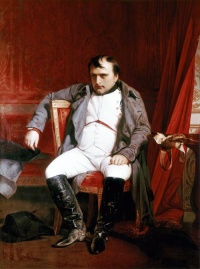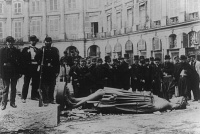Napoleon
From The Art and Popular Culture Encyclopedia
| Revision as of 20:29, 11 May 2010 Jahsonic (Talk | contribs) ← Previous diff |
Current revision Jahsonic (Talk | contribs) |
||
| Line 1: | Line 1: | ||
| + | [[Image:Communards pose with the statue of Napoléon I from the toppled Vendôme column.jpg|left|thumb|200px| | ||
| + | [[Communards pose with the statue of Napoléon I from the toppled Vendôme column]]]][[Image:Napoléon Bonaparte abdicated in Fontainebleau.jpg|thumb|right|200px|''[[Napoléon Bonaparte abdicated in Fontainebleau]]'' (1845) by Paul Delaroche]] | ||
| + | {| class="toccolours" style="float: left; margin-left: 1em; margin-right: 2em; font-size: 85%; background:#c6dbf7; color:black; width:30em; max-width: 40%;" cellspacing="5" | ||
| + | | style="text-align: left;" | | ||
| + | "Some people have thought that, in the eyes of [[Napoleon]], [[religious belief]] was but a [[superstition]] consecrated by time, and that in re-establishing the [[Catholic]] religion he only made use of it as the tool of his ambition, without in any way considering the social influence of religion. Those who spoke thus | ||
| + | were ignorant of the fact that Bonaparte was sincerely religious-I may add, a true Catholic. His detestation | ||
| + | of the [[free-thinking]] [[cynicism]] which preaches contempt for religion-which was considered by him, on the contrary, as the basis of morality and decency--was as great as his horror for the bigotry which fetters human | ||
| + | intelligence. "--''[[Memoirs Illustrating the History of Napoleon I]]'' (1827) by Claude-François de Méneval | ||
| + | <hr> | ||
| + | "[[Napoleon]] was always glad to sleep in the [[bed]]s of other [[king]]s, and establish himself in [[palace]]s, from which his appearance had driven them."--''[[The Apocryphal Napoleon]]'' (1836) by Louis Geoffroy | ||
| + | |} | ||
| {{Template}} | {{Template}} | ||
| - | '''Napoleon I of France''' ([[August 15]] [[1769]]; [[Ajaccio]], [[Corsica]] – [[May 5]] [[1821]]; [[Saint Helena]]) reigned France from [[1804]] to [[1814]]. | ||
| - | ==Marriages and children== | ||
| - | [[File:Emprjose.jpg|thumb|alt=Woman with brown hair, in a white dress and tiara, sitting on a plush orange sofa|Napoleon's first wife, [[Joséphine de Beauharnais|Joséphine]], Empress of the French, painted by [[François Gérard]], 1801]] | ||
| - | Napoleon married [[Joséphine de Beauharnais]] in 1796, when he was twenty-six; she was a thirty-two-year-old widow whose first husband had been executed during the Revolution. Until she met Bonaparte, she had been known as 'Rose', a name which he disliked. He called her 'Joséphine' instead, and she went by this name henceforth. Bonaparte often sent her love letters while on his campaigns. He formally adopted her son [[Eugène de Beauharnais|Eugène]] and cousin [[Stéphanie de Beauharnais|Stéphanie]], and arranged dynastic marriages for them. Joséphine had her daughter [[Hortense de Beauharnais|Hortense]] marry Napoleon's brother, [[Louis Bonaparte|Louis]]. | ||
| - | Joséphine had lovers, including a [[Hussar]] lieutenant, [[Hippolyte Charles]], during Napoleon's Italian campaign. Napoleon learnt the full extent of her affair with Charles while in Egypt, and a letter he wrote to his brother Joseph regarding the subject was intercepted by the British. The letter appeared in the London and Paris presses, much to Napoleon's embarrassment. Napoleon had his own affairs too: during the Egyptian campaign he took Pauline Bellisle Foures, the wife of a junior officer, as his mistress. She became known as ''[[Cleopatra]]'' after the [[Ancient Egypt]]ian ruler. | + | '''Napoleon Bonaparte''' (1769 – 1821), was a [[military and political leader]] of [[France]] whose actions shaped [[European politics]] from 1804 to 1814. |
| - | :One night, during an illicit liaison with the actress Marguerite George, Napoleon had a major fit. This and other more minor attacks have led historians to debate whether he had epilepsy and, if so, to what extent. | + | ==Image== |
| + | :''[[cultural depictions of Napoleon]]'' | ||
| + | Napoleon has become a worldwide [[cultural icon]] who symbolises military [[genius]] and [[political power]]. Since his death, many towns, streets, ships, and even cartoon characters have been named after him. He has been portrayed in hundreds of films and discussed in hundreds of thousands of books and articles. | ||
| - | While Napoleon's mistresses had children by him, Joséphine did not produce an heir, possibly because of either the stresses of her imprisonment during [[the Terror]] or an abortion she may have had in her twenties. Napoleon ultimately chose divorce so he could remarry in search of an heir. In March 1810, he married by [[proxy marriage|proxy]] [[Marie Louise, Duchess of Parma|Marie Louise]], Archduchess of Austria, and a great niece of [[Marie Antoinette]]; thus he had married into a [[German monarchs family tree|German royal and imperial family]]. They remained married until his death, though she did not join him in exile on Elba and thereafter never saw her husband again. The couple had one child, [[Napoleon II of France|Napoleon Francis Joseph Charles]] (1811–1832), known from birth as the [[King of the Romans|King of Rome]]. He became Napoleon II in 1814 and reigned for only two weeks. He was awarded the title of the Duke of Reichstadt in 1818 and died of [[tuberculosis]] aged 21, with no children. | + | During the Napoleonic Wars he was taken seriously by the British press as a dangerous [[tyrant]], poised to invade. A [[nursery rhyme]] warned children that Bonaparte ravenously ate naughty people; the '[[bogeyman]]'. The British [[Tory]] press sometimes depicted Napoleon as much smaller than average [[Human height|height]] and this image persists. Confusion about his height also results from the difference between the [[French units of measurement|French pouce]] and [[Imperial units|British inch]]—2.71 and 2.54 cm respectively; he was about 1.7 metres tall, average height for the period (see also [[Sade's appearance]]). |
| - | Napoleon acknowledged two illegitimate children: | + | In 1908 psychologist [[Alfred Adler]] cited Napoleon to describe an [[inferiority complex]] in which short people adopt an overaggressive behavior to compensate for lack of height; this inspired the term ''[[Napoleon complex]]''. The [[stock character]] of Napoleon is a comically short "petty tyrant" and this has become a [[cliché]] in [[popular culture]]. He is often portrayed wearing a comically large [[bicorne]] and a [[hand-in-waistcoat]] gesture—a reference to the 1812 painting by Jacques-Louis David. |
| - | *[[Charles Léon]], (1806–81) by [[Louise Catherine Eléonore Denuelle de la Plaigne]] | + | |
| - | *[[Count Alexandre Joseph Colonna-Walewski]], (1810–68) by [[Countess Marie Walewska]] | + | |
| - | He may have had further unacknowledged illegitimate offspring as well: | + | |
| - | *Karl Eugin von Mühlfeld, by Victoria Kraus | + | |
| - | *[[Hélène Napoleone Bonaparte]] (1816–1910) by [[Albine de Montholon]] | + | |
| - | *[[Jules Barthélemy-Saint-Hilaire]], whose mother also remains unknown. | + | |
| == Trivia == | == Trivia == | ||
| In [[1801]], [[Napoleon I of France|Napoleon Bonaparte]] ordered the arrest of the anonymous author of ''[[The Misfortunes of Virtue|Justine]]'' and ''[[L'Histoire de Juliette|Juliette]]'' | In [[1801]], [[Napoleon I of France|Napoleon Bonaparte]] ordered the arrest of the anonymous author of ''[[The Misfortunes of Virtue|Justine]]'' and ''[[L'Histoire de Juliette|Juliette]]'' | ||
| + | ==See also== | ||
| + | *[[Napoleon's love life]] | ||
| + | **[[Ne te lave pas... J'arrive! ]] | ||
| + | *[[Mémoires autour de Napoléon I]] | ||
| + | *[[Le grand vainqueur: Anonymous caricature of Napoleon]] | ||
| + | *[[Napoleon in Caricature]] | ||
| + | *[[English Caricature and Satire on Napoleon I]] | ||
| + | *[[Code Napoleon]] | ||
| + | *[[Napoleon (2023 film)]] | ||
| + | |||
| {{GFDL}} | {{GFDL}} | ||
Current revision

|
"Some people have thought that, in the eyes of Napoleon, religious belief was but a superstition consecrated by time, and that in re-establishing the Catholic religion he only made use of it as the tool of his ambition, without in any way considering the social influence of religion. Those who spoke thus were ignorant of the fact that Bonaparte was sincerely religious-I may add, a true Catholic. His detestation of the free-thinking cynicism which preaches contempt for religion-which was considered by him, on the contrary, as the basis of morality and decency--was as great as his horror for the bigotry which fetters human intelligence. "--Memoirs Illustrating the History of Napoleon I (1827) by Claude-François de Méneval "Napoleon was always glad to sleep in the beds of other kings, and establish himself in palaces, from which his appearance had driven them."--The Apocryphal Napoleon (1836) by Louis Geoffroy |
|
Related e |
|
Featured: |
Napoleon Bonaparte (1769 – 1821), was a military and political leader of France whose actions shaped European politics from 1804 to 1814.
Image
Napoleon has become a worldwide cultural icon who symbolises military genius and political power. Since his death, many towns, streets, ships, and even cartoon characters have been named after him. He has been portrayed in hundreds of films and discussed in hundreds of thousands of books and articles.
During the Napoleonic Wars he was taken seriously by the British press as a dangerous tyrant, poised to invade. A nursery rhyme warned children that Bonaparte ravenously ate naughty people; the 'bogeyman'. The British Tory press sometimes depicted Napoleon as much smaller than average height and this image persists. Confusion about his height also results from the difference between the French pouce and British inch—2.71 and 2.54 cm respectively; he was about 1.7 metres tall, average height for the period (see also Sade's appearance).
In 1908 psychologist Alfred Adler cited Napoleon to describe an inferiority complex in which short people adopt an overaggressive behavior to compensate for lack of height; this inspired the term Napoleon complex. The stock character of Napoleon is a comically short "petty tyrant" and this has become a cliché in popular culture. He is often portrayed wearing a comically large bicorne and a hand-in-waistcoat gesture—a reference to the 1812 painting by Jacques-Louis David.
Trivia
In 1801, Napoleon Bonaparte ordered the arrest of the anonymous author of Justine and Juliette
See also
- Napoleon's love life
- Mémoires autour de Napoléon I
- Le grand vainqueur: Anonymous caricature of Napoleon
- Napoleon in Caricature
- English Caricature and Satire on Napoleon I
- Code Napoleon
- Napoleon (2023 film)


